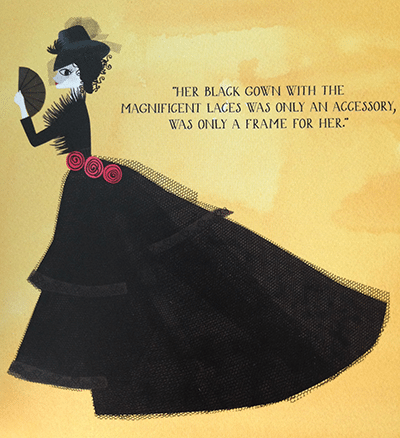by Vicki Palmquist
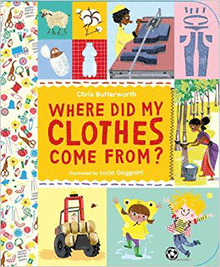 (A) If your kids are plugged in to Project Runway or
(A) If your kids are plugged in to Project Runway or
(B) if you come from a tradition of sewing clothes in your family or
© if you’ve ever been asked about where jeans come from …
this is the right book for your 5- to 8‑year-old. Where Did My Clothes Come From? by Chris Butterworth, with illustrations by Lucia Gaggiotti (Candlewick Press, 2015) is a nifty book with words and drawings that combine to give satisfying answers.
From jeans to fleece jackets to party dresses, from cotton to silk to polyester, each fabric is created from natural fibers grown as plants or sheared from animals or else it’s created from a “sticky syrup” made up of chemicals. The author and illustrator walk us through the process from the cloth’s origin to the cleaning to the factory to the fabric.
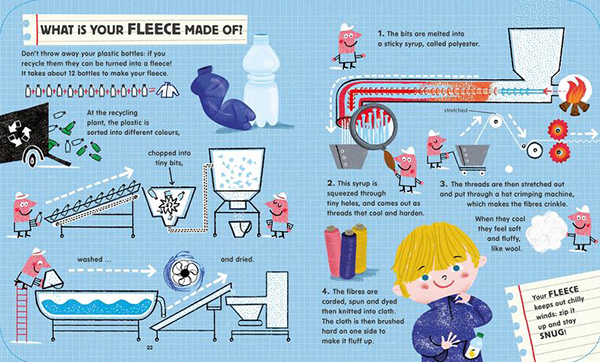
Ms. Butterworth’s language is clear in a straightforward story that will answer questions and stimulate interest. Ms. Gagliotti’s illustrations provide vital information. When the author, writing about jeans, says that “the cloth is cut into shapes,” she gives us a drawing of someone who is doing that cutting on a well-detailed table, followed by the cut pieces laid out in a before-you-sew-the-jeans diagram with labeled parts. For this reader, everything makes sense.
I’ve never wanted to know too exactly where polyester and fleece come from but, thanks to this book, now I know. A section on recycling encourages us to recycle plastic beverage bottles to be made into fleece jackets and cut down jeans for a skirt when the knees are worn.
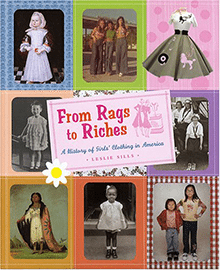 Another book on this subject is From Rags to Riches: a History of Girls’ Clothing in America by Leslie Sills (Holiday House, 2005). The book is out of print but you may find it in your library or as a used book. It’s worth tracking down. Excellent photo choices and lively descriptions and facts will inform kids about the fashions that have come and gone and still inspire us. Even better, the author looks at history through fashion, a particular viewpoint that will find kids thinking more deeply about their current experiences.
Another book on this subject is From Rags to Riches: a History of Girls’ Clothing in America by Leslie Sills (Holiday House, 2005). The book is out of print but you may find it in your library or as a used book. It’s worth tracking down. Excellent photo choices and lively descriptions and facts will inform kids about the fashions that have come and gone and still inspire us. Even better, the author looks at history through fashion, a particular viewpoint that will find kids thinking more deeply about their current experiences.
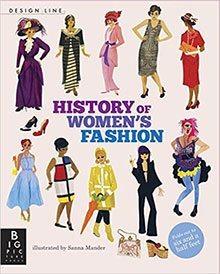 This just in: History of Women’s Fashion by Sanna Mander (Big Picture Press, 2015). What an astounding book! It has just one page which folds out to 6−1÷2 feet! That one page is printed on both sides. On the front, there is a timeline of clothing and accessories women have worn from 1900 to the present, with approximately 15 drawings on each section of that page. It all folds down to fit within the pages of a folio-sized book.
This just in: History of Women’s Fashion by Sanna Mander (Big Picture Press, 2015). What an astounding book! It has just one page which folds out to 6−1÷2 feet! That one page is printed on both sides. On the front, there is a timeline of clothing and accessories women have worn from 1900 to the present, with approximately 15 drawings on each section of that page. It all folds down to fit within the pages of a folio-sized book.
We see women wearing the clothes so we get the idea of how bodies were affected by the dresses and pants and corsets! The first item on the timeline is a corset. We are shown a bathing suit from 1917 (modestly covering the entire body), a Coco Chanel pleated skirt and jacket from 1924, a Land Girl Uniform from 1939, a Christian Dior Black Dress from 1955, a punk dress from 1980, and an Alexander McQueen ensemble, with plenty of styles in between. On the back side of that one page are silhouettes of the drawings on the front with text explaining what we’re seeing and the significance of the style.
I love this book now but I would have especially loved it as a teen because I was endlessly designing clothes and drawing them on models. Think how much fun your budding designer would have! This gets top marks from me for inventiveness and a fun way to absorb information.
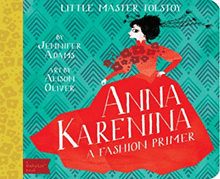 And then, because I can’t resist board books for adults, you might look at Anna Karenina: a Fashion Primer the next time you’re in your favorite bookstore. Written by Jennifer Adams, with evocative art by Alison Oliver (Gibbs Smith, 2014), this book is part of the publishers’ BabyLit series. I’m still puzzling over this one. With quotes from Leo Tolstoy and focusing on fashion words and images, perhaps instilling love of great adult literature is starting (too) early? But it would be a great conversation starter at your next literary dinner party or book club.
And then, because I can’t resist board books for adults, you might look at Anna Karenina: a Fashion Primer the next time you’re in your favorite bookstore. Written by Jennifer Adams, with evocative art by Alison Oliver (Gibbs Smith, 2014), this book is part of the publishers’ BabyLit series. I’m still puzzling over this one. With quotes from Leo Tolstoy and focusing on fashion words and images, perhaps instilling love of great adult literature is starting (too) early? But it would be a great conversation starter at your next literary dinner party or book club.
